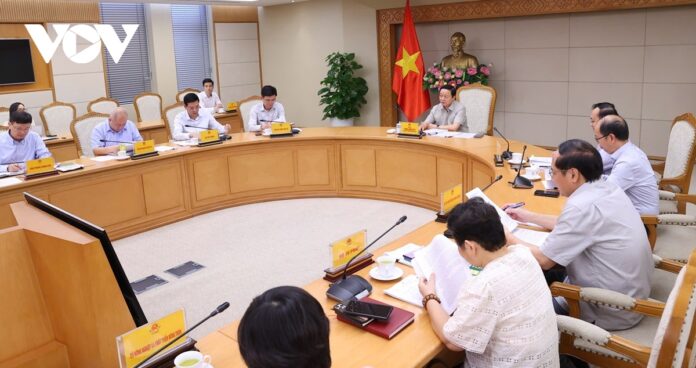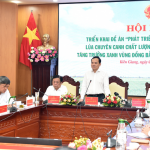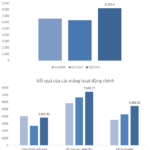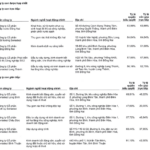On August 22, Deputy Prime Minister Tran Hong Ha chaired a meeting at the Government Headquarters to approve the proposal for developing a carbon market in Vietnam. The proposal aims to proactively develop a domestic carbon market that complies with the country’s practical conditions and development orientation, its international commitments to greenhouse gas emission reduction, and the global carbon market trends. This approach will maximize the resources of domestic economic components in greenhouse gas emission reduction activities.

Deputy Prime Minister Tran Hong Ha chairs the meeting to approve the proposal for developing Vietnam’s carbon market
The Deputy Prime Minister emphasized that with its vast potential for renewable energy and the carbon market, Vietnam will be highly attractive to investors. He stated, “This is a race where the quickest wins, and those who are smart will seize the opportunity to catch up and even surpass others.”
The Deputy Prime Minister requested the Ministry of Finance to thoroughly study and incorporate the contributions, promptly finalizing the proposal, not only for the carbon market but also for the organizational structure and infrastructure.
The Deputy Prime Minister assigned the Ministry of Finance, the Ministry of Natural Resources and Environment, the Ministry of Planning and Investment, and relevant ministries to coordinate and determine the supply and demand of the domestic and international carbon markets. They are also tasked with establishing a legal framework to calculate, measure, and identify the products traded on the carbon market, such as greenhouse gas emission allowances and various types of carbon credits. This will serve as the basis for developing a comprehensive operating plan for the domestic exchange and the conditions for connecting with the international market, ensuring transparency, publicity, and preventing speculation.
According to the latest draft, the proposal aims to develop a carbon market in Vietnam, contributing to the goal of reducing greenhouse gas emissions as per the nationally determined contributions (NDCs) with minimal costs to businesses and society.
The carbon market will create a new financial stream for greenhouse gas emission reduction activities, promote a green transition, foster low-emission technology development, and advance a low-carbon economy. It will also enable proactive responses to climate change, aiming for net-zero emissions by 2050.
From 2025 to 2028, the carbon market will be piloted nationwide. During this phase, carbon credits will not be sold abroad, and there will be no regulations on connecting or exchanging carbon credits domestically with regional and global carbon markets. The entire emission allowance will be allocated for free, and there will be no auctions. Greenhouse gas emission allowances will be distributed to major emitting sectors.
The types of carbon credits permitted for trading on the market include those obtained from programs or projects that generate domestic credits as per domestic legal regulations and those obtained through international carbon credit exchange and offset mechanisms.
The entities participating in buying and selling on the market are large greenhouse gas-emitting facilities in sectors determined by the Prime Minister, which are allocated emission allowances, and organizations or individuals participating in buying and selling carbon credits on the exchange.

Deputy Prime Minister Tran Hong Ha
From 2029 onwards, the carbon market will be officially operated nationwide, with continued development and improvement of laws and infrastructure to connect the domestic carbon market with regional and global carbon markets.
Most of the greenhouse gas emission allowances will be allocated for free, with the remaining portion allocated through auctions. Additional types of certified carbon credits may be considered for trading on the market.
The entities participating in emission allowance trading are facilities that emit greenhouse gases and are subject to greenhouse gas inventory requirements.
The entities participating in carbon credit trading are organizations implementing programs or projects that generate domestic carbon credits or those implementing programs or projects under international carbon credit exchange and offset mechanisms, in accordance with domestic legal regulations and international treaties to which Vietnam is a signatory. They also include organizations and individuals eligible to engage in carbon credit investment and trading activities.
The Hanoi Stock Exchange and the Vietnam Securities Depository and Settlement Corporation will build and provide services for the domestic carbon credit exchange, meeting the business requirements for market organization and management and the technical conditions and standards developed by the Ministry of Natural Resources and Environment. The Ministry of Natural Resources and Environment is responsible for operating, managing, monitoring, and supervising the carbon credit market.
Bình Thuận’s Dragon Fruit: A New Path for Sustainable Agriculture and Reduced Emissions
The initial successes in growing dragon fruit and reducing greenhouse gas emissions, as well as carbon footprint tracking in Binh Thuan, are evidence that Vietnam has, is, and will be able to apply innovative approaches to develop sustainable agriculture, adapting to climate change…
Implementing ‘Decompression’ Policy, Reducing Burden for Urban Areas
The development strategy for the Construction industry until 2030, aiming towards 2045, sets goals and policies to “decompress” and reduce the burden on large cities, and relocate residents to surrounding urban areas.
Low-carbon economic development: The “must-haves” for achieving a circular economy.
With a commitment to achieving net-zero emissions in Vietnam by 2050 and a commitment to combating deforestation in accordance with the EU Forest Law Enforcement, Governance and Trade (FLEGT) regulations by the end of 2024, we aim to move towards a low-carbon economy, paving the way for circular economic development for businesses.














































